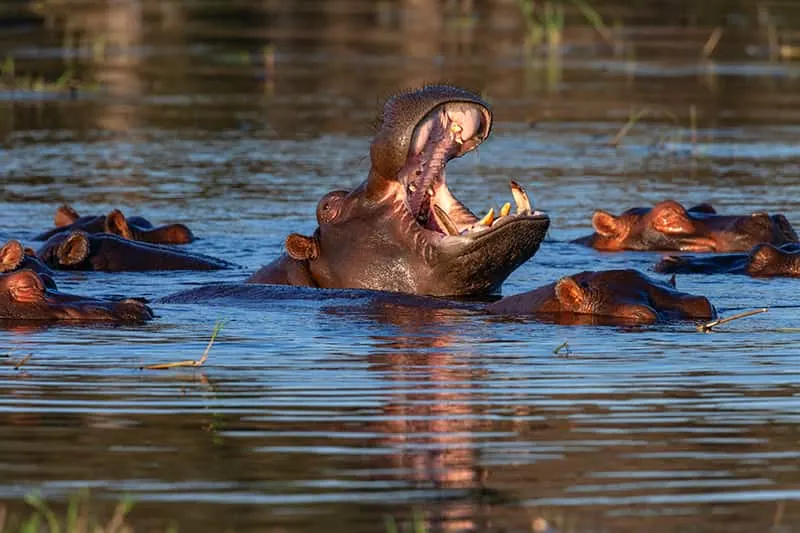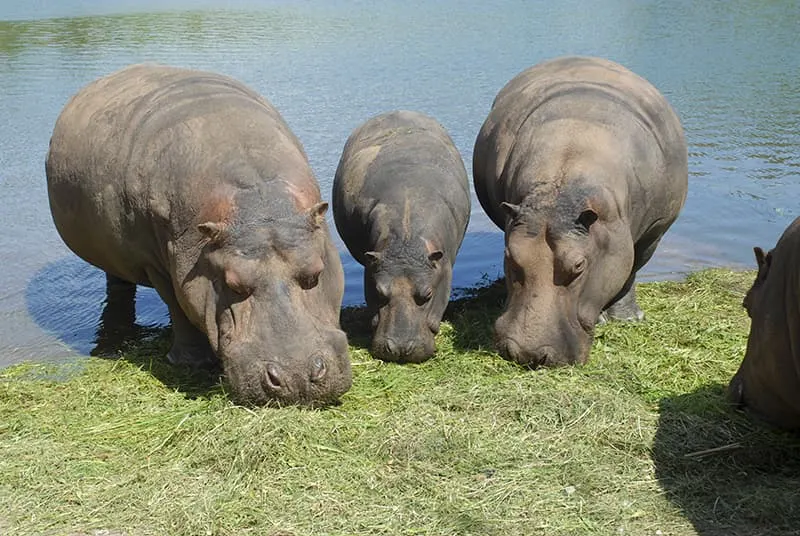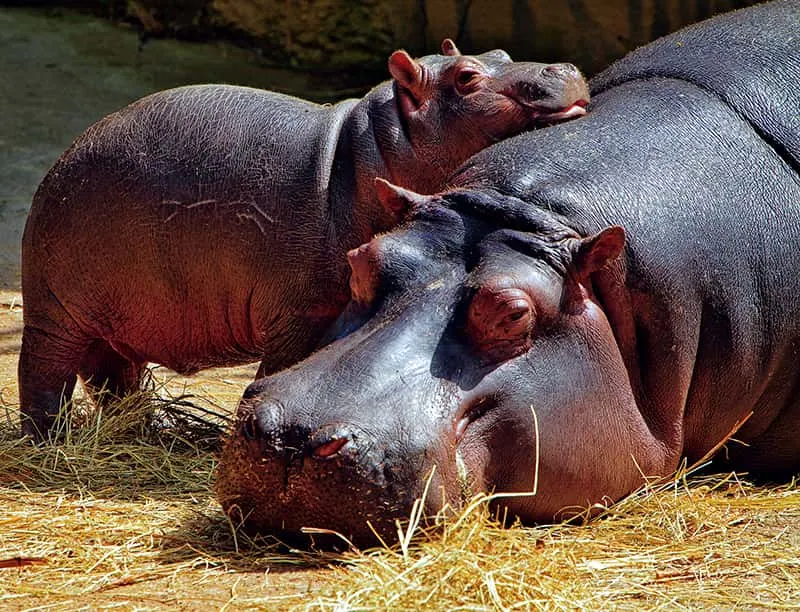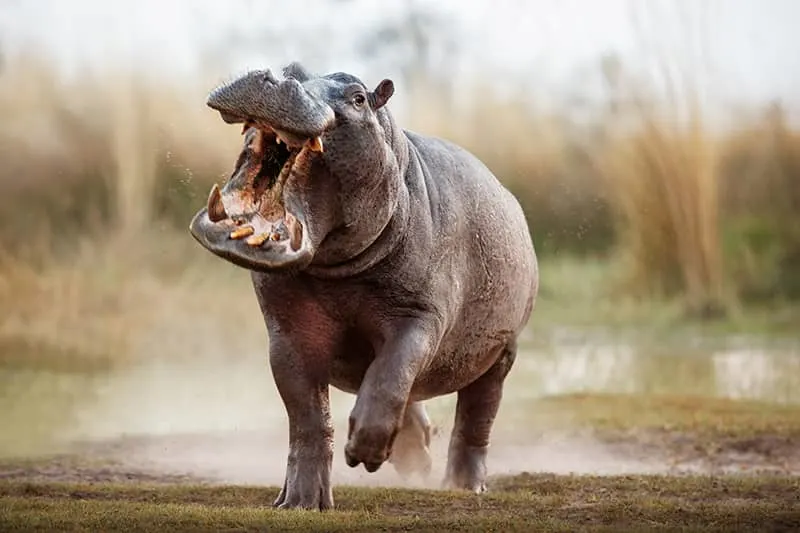Want to learn some interesting facts about hippos? You will learn all about hippos in this post! We will be talking about their physical description, habitat, offspring, and more!

The two species of hippopotamus are the common hippopotamus and the pygmy hippopotamus. The main differences between the two are as follows:
- The pygmy hippo is much smaller. It weighs a fourth less than the common hippo and is half as tall.
- The pygmy hippo's face is different from the common hippo’s. Its head and mouth are narrower, and its eyes are on the side of its head.
- Pygmy hippos spend less time in the water.
- Pygmy hippos have a limited range. They can only be found in the rainforests of four countries in West Africa.
- Pygmy hippos are solitary creatures.
- Pygmy hippos are listed as “Endangered” on the IUCN Red List.
Read more about the pygmy hippopotamus.
In this post, we will be discussing the common hippopotamus.
Physical Description
The hippopotamus is a large creature with a huge head. It has small ears and eyes, and a long nose. Hippos have large, barrel-shaped bodies. They have four short legs and four toes with hoof-like nails on each foot.
The coat of a hippo is gray or brown. Hippos have short, flat tails. There are a few tufts of bristly hair on a hippo’s nose, ears, and tail.
A male hippo can grow to nine thousand pounds. Female hippos are smaller than males and weigh about three thousand pounds. Hippos can grow to five feet tall. They can be from eleven to sixteen feet in length.
Habitat
Common hippos can be found in twenty-nine countries in sub-Saharan Africa. Their range includes the countries of Uganda, Kenya, Somalia, Ethiopia, and South Africa. They are found living in habitats near water. Hippopotamuses live near swamps, slow-moving rivers, and lakes.

Habits
Hippos spend more time in the water than they do on land. They can spend up to sixteen hours a day submerged in mud or water. Hippopotamus need to keep their skin wet to survive. They dehydrate easily.
Common hippos move easily through water, but they don't swim. They push off objects with their feet to propel themselves through the water. They spend their days in the water and come ashore to eat at night.
Hippos are unable to sweat to control their body temperature like we do. They do not have natural protection against the sun. To compensate for this, they secrete an oily red liquid called “blood sweat.” This liquid protects a hippo’s skin in three ways.
When “blood sweat” dries on a hippo's skin, it acts as a sunscreen. When a hippo has a gaping wound, the chemicals in the “blood sweat” prevent infection. Scientists also believe that “blood sweat” serves as an insect repellant.
Common hippopotamuses are social creatures and spend their time in herds. A hippo herd typically has ten to thirty members.
A dominant male hippo leads a herd of other males, females, and offspring. The dominant male hippo earns the right to lead his herd by fighting other males. This allows him to choose the females he wants to mate with first. After he chooses, the other males fight each other to earn the right to mate with the other female hippos.
Common hippos are notorious for their unpredictable and aggressive nature. They use their powerful bite to attack possible predators. Females are aggressive and attack to protect their young.
Hippos are very aggressive towards people. They attack, bite, and capsize boats in the water. They target humans on land as well. If hippos see someone standing in the way of their water source, they will attack that person.
Diet

Common hippos are herbivores and love grazing on long grass. They also eat small plants, fruit, reeds, and other vegetation. Hippos can go for three weeks without food because they can store food in their stomachs. Hippopotamus typically eat about ninety pounds of food each night. They don't use their teeth to chew their food. They use their lips to soften the food before swallowing it.
Offspring
Hippos breed during the dry season in their environment. They typically give birth during the wettest season. Mother hippos are pregnant for eight months. She leaves her herd about two weeks before giving birth.
Mother hippopotamuses give birth to one calf that weighs from fifty to one hundred and ten pounds. A hippo mother has a close relationship with her baby. They rejoin the herd when the baby is about two weeks old.
The males in the herd guard the mothers and babies. Female hippos in the herd help by babysitting the young hippos. Hippo babies nurse underwater or on land for about eight months. The herd looks after the juvenile hippos until they reach adulthood.
Hippos reach adulthood around the age of seven. At this time, male hippos will start competing for dominance in the herd. Both the male and female hippos begin mating at this age.

Classification/Taxonomy
Kingdom: | Animalia
Phylum: | Chordata
Class: | Mammalia
Order: | Artiodactyla
Family: |Hippopotamidae
Genus: | Hippopotamus
Species: | Hippopotamus amphibius
History
Scientists believe that hippos share a common ancestor with whales, dolphins, and porpoises. This ancestor walked the earth about sixty million years ago. During the Ice Age, hippos lived in England, Europe, Asia, and Africa.
Predators
Both baby and juvenile hippos are at risk from natural predators. Crocodiles, lions, hyenas, and leopards are common predators of young hippopotamuses. Adult hippopotamuses have no natural predators. Humans are the only predators of adult hippopotamuses.
People hunt hippos illegally for their meat, hides, and teeth. Illegal hunting is the biggest threat to the common hippo population.
Another threat to common hippos is habitat loss. Grazing lands are being cleared to make way for farming and buildings. As a result, hippos are drawn to areas with a human population. This leads to hippos being killed as people defend their homes and farms.
Even though common hippos have been given protected areas to live in, their population still goes down each year.
The common hippopotamus is listed as “vulnerable” on the IUCN Red List.
Lifespan
Hippos typically live forty years in the wild and can live up to sixty-five years in captivity.

What Sound Does a Hippo Make?
To hear what sound a hippo makes, click on this audio file.
25+ Unusual Facts About the Common Hippo
- The common hippo is the world’s 3rd largest land mammal.
- The word “hippopotamus” comes from a Greek word that means “river horse”.
- Hippos can run faster than humans at 30 miles per hour.
- Hippos do not eat people but will attack people if they feel threatened.
- Common hippos are more territorial in the water than on land.
- “Blood sweat” is clear but turns red when exposed to air.
- Hippo herds can have as many as 200 members.
- Hippo herds are also called “schools, bloats, pods, or sieges.”
- “Blood sweat” is named for its appearance. It's neither blood nor sweat.
- Male hippos mark their territory by flinging their poop with their tails.
- Adult hippos can hold their breath for up to 5 minutes underwater.
- A hippo's bite is twice as strong as a tiger's bite.
- A hippo opens its mouth all the way to signal that it may attack.
- Hippos are the deadliest large land mammals on the planet.
- An estimated 500 deaths a year are from hippopotamus attacks.
- The teeth of a hippo can grow up to 20 inches.
- Snorts, grunts, and wheezes from a hippo are as loud as rock concert speakers.
- Hippos have been known to eat meat from dead carcasses on occasion.
- Hippos will travel up to 6 miles at night to find food to eat.
- Hippopotamus eat 1.5% of their body weight each day, which is less than a cow eats.
- A male hippo is called a “bull”, a female hippo is called a “cow”, and a baby hippo is called a “calf”.
- When a hippo calf is born, it is nearly ten times the size of a human infant.
- Mother hippopotamuses give birth both on land and in the water.
- Newborn hippos can only hold their breath for 40 seconds underwater.
- A baby hippo will stand on its mom's back while the mom searches for food underwater.
- Hippos can take naps underwater.
- Female hippos only mate once every two years.
- When hippos are underwater, their eyes are protected by a clear membrane eyelid.
- Hippos have a good sense of smell and hearing but poor vision.
- The ears and nostrils of a hippo shut automatically to keep water out.
- The size of a hippo’s territory depends on how much water and food are available in the area.
- “Lu” the hippo lives in Florida State and is the oldest living hippo in North America.
- The closest living relatives of hippopotamuses are whales.
- The Egyptians had hippos in a zoo about 3,500 years ago.
- The mouth of a common hippo can open to four feet wide.
We hope you had fun learning all about common hippos! Did you learn anything new? Let us know what else you know about them. We can’t wait to hear more!
You don't want to miss learning about these cool mammals.
